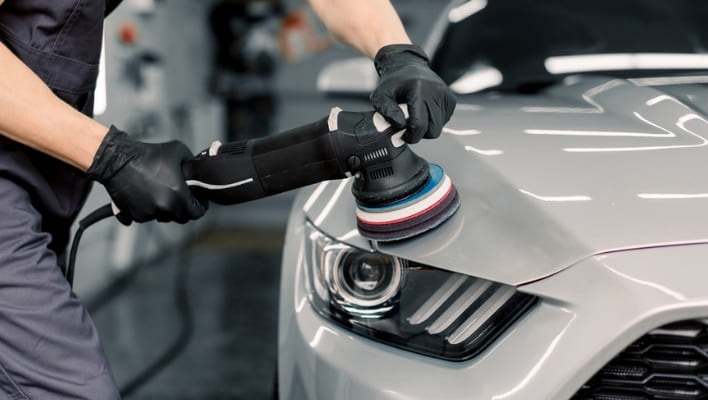A man expressed frustration after spending $2,400 on a car paint job that resulted in noticeable dirt and drips. What if I could provide you with detailed instructions on how to prep a car for paint yourself simultaneously saving you time and money?
So, when it comes to updating your car’s appearance, fixing minor damage, or just giving it a fresh coat of paint, doing the job yourself can be a cost-effective solution. Nevertheless, a professional-looking, long-lasting finish depends on thoroughly preparing your car for painting. When painting a car, many people focus solely on paint application. Generally, 90% of the time dedicated to car preparation and only 10% to the actual painting process.
If you plan to paint your car, make sure you prepare the surface properly. Getting through the preparation process too quickly can result in messy and unsatisfactory results.
Car paint prep involves a series of essential steps that ensure the paint adheres well and provides a durable finish. In this article, we’ll guide you through the process of how to do auto body paint prep, step by step, so you can transform your car’s appearance with confidence.

Table of Contents
- How To Prep Car For Paint- step By Step
- What steps are needed to prep a car for paint?
- Getting the Tools and Materials You Need
- Cleaning and Washing the Car
- Removing Old Paint and Rust
- Filling and Sanding Imperfections
- Masking and Protecting Areas
- Priming the Surface
- Choosing the Right Paint
- Applying the Paint
- Drying and Curing the Paint
- Buffing and Polishing
- Final Touches and Reassembly
- Tips and Tricks for a Professional Finish
- Conclusion On auto paint preparation:
- FAQS On Prep A Car For Painting
- Can I paint my car without sanding it?
- Is it possible to paint over existing automotive paint?
- Can I paint my car a different color than the original?
- How long should I wait before waxing my newly painted car?
- What happens if I paint a car without primer?
- Should I sand the primer before painting a vehicle?
- How many coats of primer should I apply on a car?
- How many coats of paint should I apply on a car?
How To Prep Car For Paint- step By Step
A rushed or skipped preparation process can lead to unsightly and uneven finishes, which are more costly to repair. Therefore, preparing your car for painting requires the appropriate tools and materials, an appropriate workspace, and following the correct steps.
What steps are needed to prep a car for paint?
- Gathering the necessary tools and materials
- Cleaning and washing the car
- Remove old paint and rust
- Filling and sanding imperfections
- Masking and protecting areas
- Priming the surface
- Choosing the right paint
- Applying paint
- Drying and curing the paint
- Buffing and polishing
- Final touches and reassembly
Getting the Tools and Materials You Need
To get started with prepping your car for painting, you’ll require some essential tools and materials. Here’s a list of items you’ll need:
- Sandpaper in various grits (e.g., 320, 600, 1200)
- Paint stripper
- Body filler
- Putty knife
- Sanding block
- Masking tape and paper
- Plastic sheeting
- Cleaning solution or car wash soap
- Microfiber towels
- Primer
- Automotive paint
- Automotive paint gun or paintbrush.
- Safety equipment (gloves, goggles, masks)
Cleaning and Washing the Car
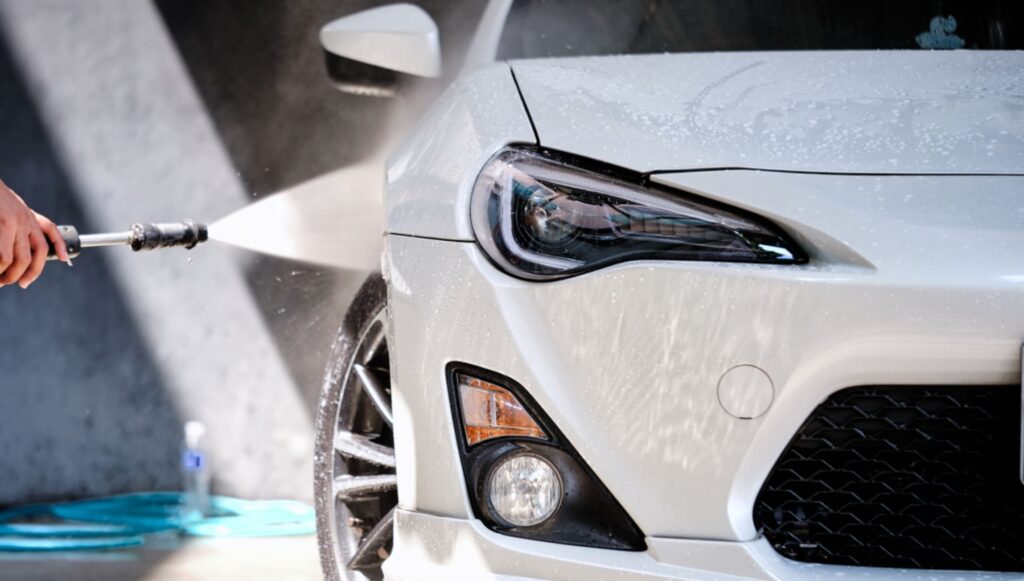
Automotive paint prep begins with thoroughly cleaning and washing the entire surface. The steps are as follows:
- The first step is to remove any loose dirt, debris, or grime from the exterior of the car. If possible, clean hard-to-reach spots with a soft brush.
- Dilute car wash soap with water to prepare a cleaning solution. Start washing the car from the roof and work your way down with a sponge or microfiber cloth.
- Pay special attention to areas prone to accumulation, such as wheel wells and crevices. After washing the car, thoroughly rinse it to remove any soap residue.
- Dry the surface using clean microfiber towels. Now, prepare the vehicle for the next step by completely drying it.
Useful Resource: Car paint blisters can be a headache, but you can easily learn how to fix paint blisters on car with our beginner-friendly tips.
Removing Old Paint and Rust
If there is any existing paint or rust on the surface, you will need to remove it before painting to achieve a smooth, even surface. Follow these steps:
- Start by sanding the entire car with coarse-grit sandpaper (e.g. 320 grit). It helps remove the top layer of paint and promotes new coat adhesion.
- Paint strippers are useful for removing stubborn paint. Scrape off the softened paint using a putty knife after applying the stripper according to the manufacturer’s instructions.
- Look for rusted areas on the car. Removing rust with sandpaper or wire brushes will bring the metal back to its original state.
- Use a rust converter or rust inhibitor in rusted areas for further corrosion prevention.
I understand the significance of addressing concerns such as old rusty paint, dents and scratches. Based on my experience, all imperfections from your car can be removed if all paint correction steps are followed correctly. However, it is important to note that the cost of professional paint correction can differ depending on factors such as the severity of the damage and the specific vehicle involved.
Filling and Sanding Imperfections
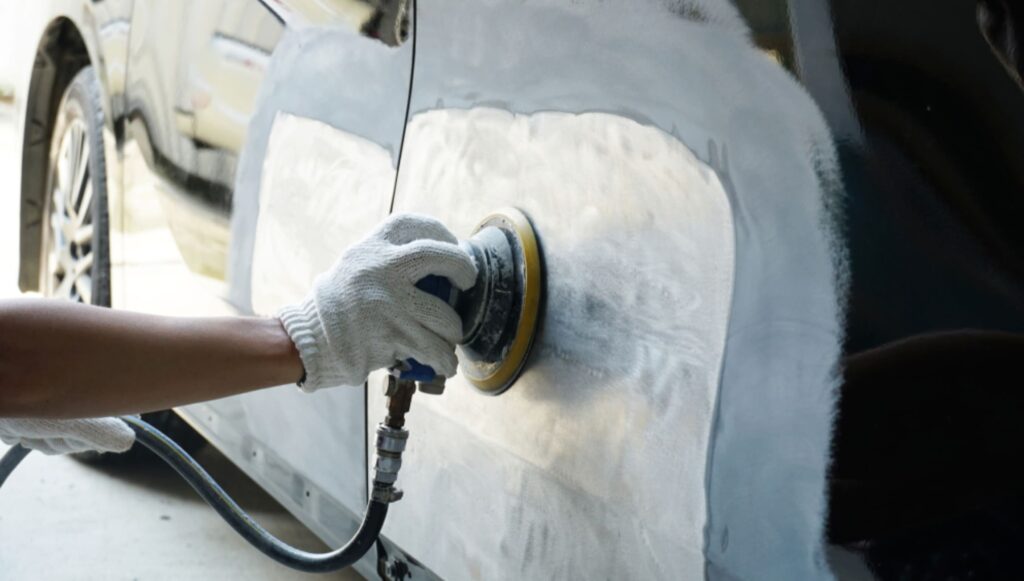
Next, you need to fix any dents, scratches, and imperfections on the car’s surface. Here are the steps to follow: Check for visible dents and scratches. Bondo is an excellent body filler for damaged areas. Apply the filler and smooth it out evenly using a putty knife. Once the filler has dried, smooth the surface with sandpaper.
Sand with coarse-grit sandpaper and then switch to finer grains (e.g., 600, 1200) for a polished finish. After that, you can clean debris with a microfiber cloth.
Masking and Protecting Areas

It is important to mask off and protect areas that shouldn’t be painted before painting. You need to follow the below steps:
- Cover windows, lights, trim, and any other unpainted parts with masking tape and paper. Protect your work area from overspray by using a tight seal.
- Keep paint and dust out of larger areas with plastic sheeting, including the engine bay and interior.
Priming the Surface
A primer coat provides a smooth base for painting and promotes paint adhesion. Here are steps to prime the car surface.
- Select a primer that fits the surface and type of paint on your car. For this purpose, you can contact your local automotive store for recommendations.
- Prepare the primer according to the manufacturer’s instructions and pour it into the paint tray.
- Apply an even coat of primer to the entire car’s surface using a roller or a sprayer. Be sure to cover every section thoroughly.
- After applying the primer, allow it to dry as directed by the manufacturer. Using fine-grit sandpaper, smooth out any imperfections once it has dried.
Important tip:
An air compressor is necessary for painting a car as it provides the air pressure needed to operate paint spray guns, ensuring a smooth and even application of paint onto the vehicle’s surface.
Choosing the Right Paint
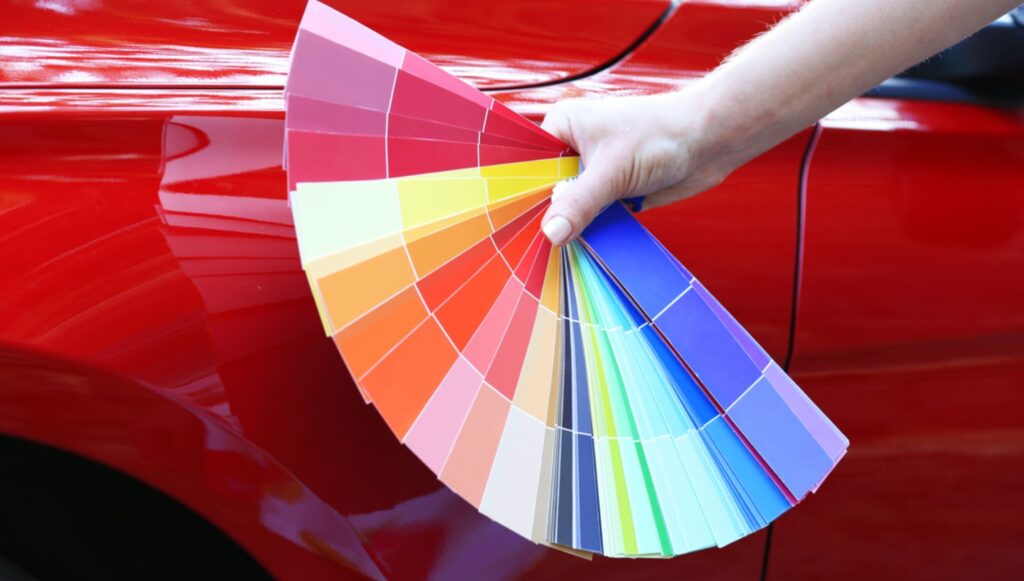
Paint selection is essential to achieving a professional and long-lasting finish on your vehicle. Here are some factors to consider:
- Type of automotive paint: Water-based, acrylic enamel, and urethane are among the various types of automotive paint. You should research each type and choose one that suits your budget and needs.
- Color selection: Select the color you want and make sure it matches the paint type you choose.
- Quality of paint: Invest in high-quality automotive paint for durability and vibrant color.
Did you know: Plasti Dip offers customization options and protection while allowing for easy removal or color changes. Here is the more detailed information about Plasti Dip.
Applying the Paint
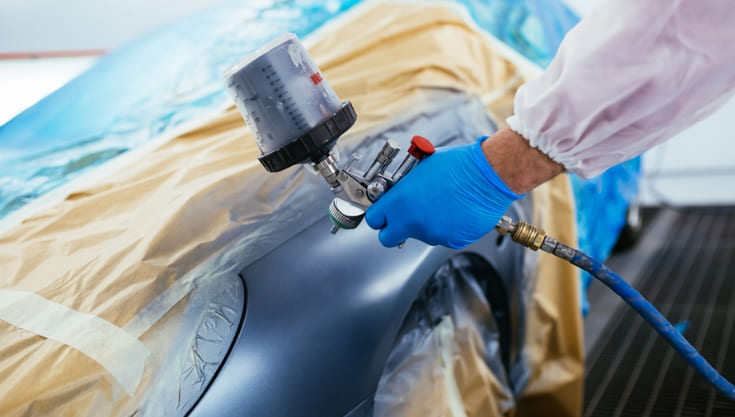
Now comes the exciting part – application of the paint.
- If you plan to paint a car with a spray gun, ensure it is properly cleaned and adjusted according to the paint manufacturer’s instructions.
- Start by applying a thin and even base coat. Spray the paint on the surface by holding it approximately six to eight inches from the surface and sweeping the paint over it.
- The base coat should dry according to the paint manufacturer’s instructions. Add additional coats as necessary, allowing each coat to dry properly between each one.
- Apply a clear coat after the final color coat for a professional finish. Clear coats add gloss and protection to paint jobs.
Drying and Curing the Paint
A flawless finish depends on proper drying and curing of the paint. The steps are as follows:
- Keep the paint well-ventilated and away from dust and debris while it dries. The paint manufacturer will provide instructions on how long it will take to dry.
- The drying process can be accelerated by using heat lamps or infrared dryers. Do not overheat the surface, as this could damage the paint. Properly allowing paint to dry is important to avoid potential paint problems.
- When the paint is dry, allow sufficient time for it to cure before handling or waxing. The period of time it takes to cure can vary, but it is generally recommended to wait at least a week.
Buffing and Polishing
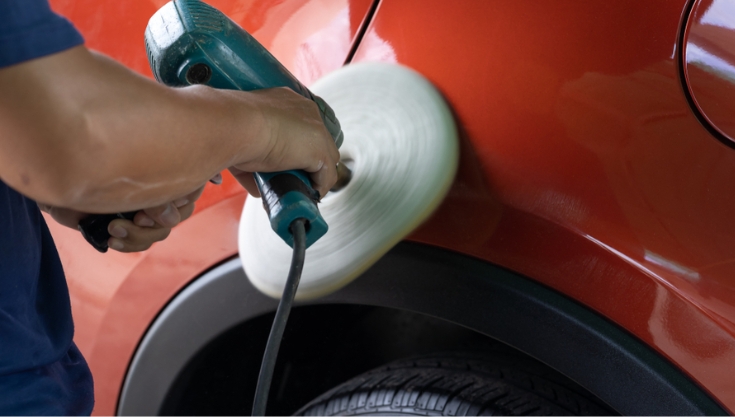
Creating a smooth and glossy finish requires buffing and polishing the painted surface. Steps to follow:
- The painted surface can then be gently buffed with a soft cloth and polishing compound once it has fully cured. As a result, imperfections and swirl marks are removed.
- Using circular motions, apply the compound in small sections until the surface is smooth and glossy.
- Use a clean cloth to remove any excess compound or residue after buffing.
Final Touches and Reassembly
Once the painting process is completed, remove the masking materials and reassemble any parts that were removed. These are the steps you should follow:
- Masking tape and paper must be carefully removed, ensuring that no paint is mistakenly removed.
- If you removed trim, accessories, or parts during the prep, you need to reattach them.
- Step back and inspect your car for any touch-ups or areas that need extra attention. Whenever you see a minor imperfection, use a small brush or touch-up pen to fix it.
- When you’re satisfied with the result, give your car a final wipe down to rid it of any dust or fingerprints. or The final step is to wipe down your car to remove any dust or fingerprints.
Tips and Tricks for a Professional Finish
Here are some tips and tricks for prepping your car for paint so that it looks professional:
- Proper ventilation: Consider using a paint booth or working in well-ventilated areas to minimize the risk of inhalation. or Work in a paint booth or in areas with good ventilation to minimize the risk of inhalation and to allow the paint to dry properly.
- Taking your time and following each step carefully will help you avoid common mistakes. If you rush through the process, the result might not be what you expected.
- Safety precautions: Use safety equipment when handling chemicals, such as gloves, goggles, and masks.
Conclusion On auto paint preparation:
An excellent car paint preparation is essential to ensuring a durable and professional finish. This article on how to prepare a car for paint will guide you through the steps to transform the appearance of your car.
With attention to detail and a careful approach, you’ll be rewarded with a beautifully painted car that you can be proud of.
FAQS On Prep A Car For Painting
Can I paint my car without sanding it?
Preparing the surface for painting requires sanding. It removes old paint, smooths out imperfections, and promotes better paint adhesion. Painting without sanding may result in a less durable and dull finish.
Is it possible to paint over existing automotive paint?
Yes, it is possible to paint over existing automotive paint. Cleaning and lightly sanding the surface are important steps in preparing the surface. The application of a primer and choosing a compatible paint type can also ensure a smooth finish. If there is any damage to the existing paint, it is also advisable to repair it.
Can I paint my car a different color than the original?
It is possible to paint your car another color. Changing the color may require additional steps, such as priming, ensuring even coverage, and possible color blending.
How long should I wait before waxing my newly painted car?
Generally, a newly painted car should wait 30 days before waxing. The paint is allowed to cure and harden during this period. A premature waxing process can interfere with the curing process.
What happens if I paint a car without primer?
When a car is painted without primer, it may peel, chip, or flake over time due to poor adhesion. Paint without primer may highlight existing flaws, such as scratches or uneven texture, resulting in uneven or bumpy surfaces.
Should I sand the primer before painting a vehicle?
Yes, it is recommended to sand the primer before painting a vehicle. It will create a smooth surface for better paint adhesion and professional finish. You can sand the primer using fine-grit sandpaper, usually between 320 and 400 grit. It allows gentle smoothing without removing too much primer.
How many coats of primer should I apply on a car?
The primer should be applied in two to three coats. It ensures a smooth paint base and proper coverage. Primer should be dried after each coat according to the manufacturer’s instructions. Generally, 15 to 20 minutes is sufficient time between coats.
How many coats of paint should I apply on a car?
It is recommended to paint a car twice or three times. This ensures proper coverage, color depth, and smooth, consistent finish.

Rosalie Sanchez
DIY enthusiast with years of experience in home decor and home improvement. With a passion for educating consumers about DIY projects. Every time, I work with our painting professionals to provide you with the best painting product reviews and how-to advice. You can follow me on Facebook.


